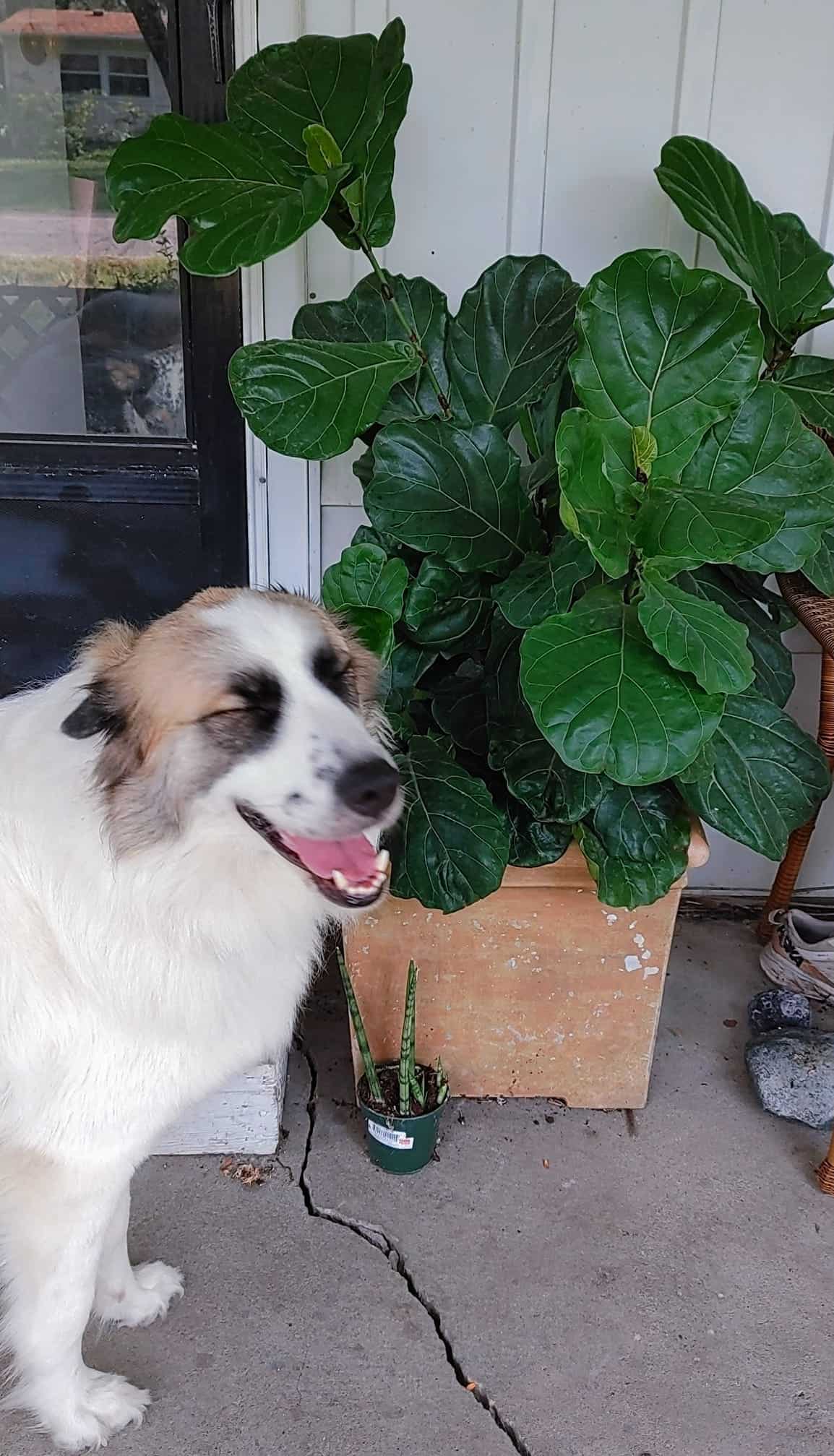Fiddle leaf figs shower air-purifying properties to humans but are biased against men’s best friend, ‘dogs.’
So, let me walk you through in-depth details about how Fiddle leaf figs are toxic to dogs alongside preventive measures.
Table of Contents Show
Which Pets Are Vulnerable to Fiddle Leaf Fig Poisoning?
Almost all pets, including dogs, cats, rabbits, guinea pigs, and birds, are vulnerable to Fiddle leaf fig poisoning.
The sap of the Fiddle leaf figs is poisonous and can induce various symptoms depending on severity.
So, it would be best if you adopted the prevention is better than cure approach.
Causes of Fiddle Leaf Figs Poisoning in Dogs
According to Australian animal poison, Fiddle leaf figs (Ficus lyrata) are toxic to dogs due to calcium oxalate crystals.
Almost all parts of the Fiddle leaf figs contain oxalate crystals, making every part toxic to dogs.

Moreover, the plant sap also contains ficin, a proteolytic enzyme that causes dog inflammation and dermatitis.
The calcium oxalate crystals subsequently permeate the mouth, tongue, throat, and stomach tissues, embedding themselves.
As a result, your dog may suffer from instant discomfort, aggravation, and gastrointestinal distress.
Symptoms of Fiddle Leaf Fig Poisoning in Dogs
The symptoms of Fiddle leaf fig poisoning can differ depending upon the amount of consumption.
A minor or tiny amount of ingestion might not develop any significant symptoms in dogs.
Moreover, the shard-like crystals cause a severe burning sensation in the mouth, discouraging dogs from eating more.
Severe symptoms will kick in sooner or later when consumed in larger quantities.
In severe cases, it can lead to a swollen respiratory tract, breathing difficulty, and kidney damage.
The common symptoms will appear shortly after consumption, so consult your vet immediately.
Diagnosis of Fiddle Leaf Figs Poisoning in Dogs
Early diagnosis of poisoning in your dog is critical since it aids and improves treatment efficiency.
Moreover, poisoning symptoms are similar to other issues like food poisoning, infection, and digestive issues.
Thus, it is crucial to confirm the poisoning causes before administering the treatments.
- Fiddle leaf figs plant looks strangled with leaves and stems lying helpless on the ground.
- Plant residue on the dog’s mouth.
- Clear nibbling signs of dog bite marks on the foliage.
- Vomits anywhere around the plant due to a burning sensation.
If you find dog vomit, carefully collect a sample to show to your vets later to make the treatment process faster.
First Aid for Fiddle Leaf Figs Poisoning in Dogs
Here are a few first-aid treatments you can follow to stabilize your poisoned dog.
- Thoroughly rinse off the dog’s mouth to wash off any residual plant parts using saline or clean water.
- Bring your pet to a well-ventilated, open area for optimal, easy breathing.
- Let them drink milk as it can ease the burning sensation, but do not force it.
- If your dog is struggling, wrap them in a soft towel or blanket to keep them calm.
- Clean their coat and paws using the soapy solution to avoid skin irritations.
- Refrain from feeding them until and unless the vet suggests or agrees to feed them.
- Give them activated charcoal per vets supervision to adsorb toxic enzymes in the stomach.
These first-aid treatments can only lower the symptoms and may work in minor poisoning.
However, you must not rely entirely on first aid and hope your dogs recover independently.
Here are some helplines that can assist you with houseplant poisoning in dogs.
- Pet poison helpline: 855-764-7661
- Animal Poison Control Center, APCC: (888) 426-4435
Also, I have enlisted first-aid pet kits that are handy in such a panicky time.
| First Aid Kid | Brand |
|---|---|
| Arca Pet Kit | ARCA |
| Rayco First Aid | Rayco International Ltd |
| Pet First Aid Kit | NM2 New Market Squared |
Recovery of Fiddle Leaf Figs Poisoning in Dogs
Dogs with Ficus lyrata poisoning will recover within 24-48 hours with proper and prompt treatments.
But dogs with severe poisoning may take more than a week to recover completely and be back on their feet.

Thus, seeking professional help as soon as possible is crucial to avoid long-term consequences.
As the toxic enzymes of Fiddle leaf fig induce diarrhea and vomiting, give your dog IV fluids to keep dogs hydrated.
Likewise, consult a vet about what to feed and not to feed during recovery.
How to Keep the Fiddle Leaf Figs Away from Dogs?
Although Fiddle leaf fig poisoning is treatable, it leaves unpleasant experiences behind. Thus, it is again better to aim for preventive measures.
To do so, I have curated some pawfect plans to keep toxic Fiddle leaf figs away from dogs.
- Spray pepper over fiddle leaf figs. This will annoy the dog’s nose and deter them from eating the plant.
- Place the plant at a height where dogs cannot reach it and keep the plant pot stable.
- Dogs do not like Marigold flowers, Bergamots and Rue. Thus, keep them near the Fiddle leaf fig to discourage their visit.
- Apply dog repellent deterrents or use lemon, citrus peels, or neem oil on the plant.
- Keep your plants in a secluded room or garden with high fences to keep dogs away.
- Offer your dogs edible grasses to satisfy their grass hunger.
Final Thought!
Dogs do weird things they are not supposed to when they are incredibly bored, so keep them entertained and regularly take them to walk.
Also, strategically position your Fiddle leaf figs at a height in the east window, ensuring optimal bright sunlight.
All The Best!


